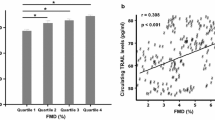Abstract
It is not clear whether radioactive iodine (RAI), one of the treatment methods for hyperthyroidism, causes endothelial dysfunction and increases cardiovascular risk in these patients. We investigated the effect of RAI treatment on carotis endothelial functions both with carotis intima media thickness (CIMT) and soluble tumor necrosis factor-like weak inducer of apoptosis (sTWEAK). Twenty-one patients in each group who received radioactive iodine treatment and antithyroid drug were included. Thyroid function tests, fasting plasma glucose (FPG), triglyceride, low-density lipoprotein (LDL), high-density lipoprotein (HDL), C-reactive protein (CRP), sTWEAK levels, and carotis intima media thickness were measured at the beginning and on the 3rd month of treatment. Both groups were compared with baseline and 3rd month data. sTWEAK levels were higher in the RAI group at baseline and on the 3rd month than in the medical group (baseline sTWEAK 78.80 vs 49.90, p = 0.004; 3rd month sTWEAK 76.60 vs 40.63, p = 0.001). CRP level was higher in the RAI group on the 3rd month than in the medical group (2.70 vs 1.49, p = 0.024). There was an increase in measurements of CIMTright and CIMT left after treatment in both the RAI and medical treatment groups, but this reached statistical significance on the CIMTright for RAI (p = 0.03) and on the CIMTleft for medical treatment group (p < 0.01). Although even low doses of RAI treatment lead to endothelial dysfunction, we did not observe such a change in terms of CIMT and TWEAK levels in as little as 3 months.

Similar content being viewed by others
Data Availability
Upon reasonable request.
References
Orloff LA, Wiseman SM, Bernet VJ, et al. American Thyroid Association statement on postoperative hypoparathyroidism: diagnosis, prevention, and management in adults. Thyroid. 2018;28:7.
Flynn R, Macdonald TM, Jung RT, et al. Mortality and vascular outcomes in patients treated for thyroid dysfunction. JCEM. 2006;9:2159–64.
Kim KJ, Song JE, Kim JY, et al. Effects of radioactive iodine treatment on cardiovascular disease in thyroid cancer patients: a nationwide cohort study. Ann Transl Med. 2020;8:1235.
Blanco-Colio LM. TWEAK/Fn14 axis: a promising target for the treatment of cardiovascular diseases. Front Immunol. 2014;5:3.
Blanco-Colio LM, Martín-Ventura JL, Munoz-Garcia B, et al. TWEAK and Fn14. New players in the pathogenesis of atherosclerosis. Front Biosci. 2007;12:3648–55.
Yilmaz MI, Carrero JJ, Ortiz A, et al. Soluble TWEAK plasma levels as a novel biomarker of endothelial function in patients with chronic kidney disease. CJASN. 2009;4:1716–23.
Xu W, Zhao Y, Liu Y. Role of the TWEAK/Fn14 pathway in autoimmune diseases. Immunol Res. 2016;64:44–50.
la Cour JL, Hedemann-Jensen P, Søgaard-Hansen J, et al. Modelingthe absorbed dose to the common carotid arteries following radioiodine treatment of benign thyroid disease. Ann Nucl Med. 2013;27:862–6.
Şanal B, Isık I, Korkmaz M, et al. Effect of radioactive iodine therapy on carotid intima media thickness in patients with hyperthyroidism. Ann Nucl Med. 2016;30:75–80.
la Cour JL, Andersen UB, Sørensen CH, et al. Radioiodine therapy does not change the atherosclerotic burden of the carotid arteries. Thyroid. 2016;26:965–71.
Kravets I. Hyperthyroidism: diagnosis and treatment. Am Fam Physician. 2016;93:363–70.
la Cour JL, Jensen LT, Vej-Hansen A, et al. Radioiodine therapy increases the risk of cerebrovascular events in hyperthyroid and euthyroid patients. Eur J Endocrinol. 2015;172:771–8.
Metso S, Auvinen A, Salmi J, et al. Increased long-term cardiovascular morbidity among patients treated with radioactive iodine for hyperthyroidism. Clin Endocrinol (Oxf). 2008;68:450–7.
An JH, Song KH, Kim DL, et al. Effects of thyroid hormone withdrawal on metabolic and cardiovascular parameters during radioactive iodine therapy in differentiated thyroid cancer. J Int Med Res. 2017;45:38–50.
Selmer C, Olesen JB, Hansen ML, et al. The spectrum of thyroid disease and risk of new onset atrial fibrillation: a large population cohort study. BMJ. 2012;345: e7895.
Siu CW, Yeung CY, Lau CP, et al. Incidence, clinical characteristics and outcome of congestive heart failure as the initial presentation in patients with primary hyperthyroidism. Heart. 2007;93:483–7.
Bartalena L, Fatourechi V. Extrathyroidal manifestations of Graves’ disease: a 2014 update. J Endocrinol Invest. 2014;37:691–700.
De Leo S, Lee SY, Braverman LE. Hyperthyroidism. Lancet. 2016;388:906–18.
Poznyaki A, Grechko AV, Poggio P, et al. The diabetes mellitus-atherosclerosis connection: the role of lipid and glucose metabolism and chronic ınflammation. Int J Mol Sci. 2020;21:1835.
Teo KK, Rafiq T. Cardiovascular risk factors and prevention: a perspective from developing countries. Can J Cardiol. 2021;37:733–43.
Roth G, Mensah GA, Johnson CO, et al. Global burden of cardiovascular diseases and risk factors, 1990–2019: update from the GBD 2019 study. J Am Coll Cardiol. 2020;76:2982–3021.
Author information
Authors and Affiliations
Contributions
ZC: conception, design, analysis, and writing. AGC: interpretation and revision. AK: anaylsis of data. EE: acquisition of data. MS: revision and final approval.
Corresponding author
Ethics declarations
Ethics Approval
The study was approved by the local institutional research ethics committee (Ankara University, 16–839-16) and certified that the study was performed in accordance with the ethical standards as laid down in the 1964 Declaration of Helsinki.
Consent to Participate
The patients gave informed consent.
Consent for Publication
Written consent for publication was taken from the participants.
Conflict of Interest
The authors declare no competing interests.
Additional information
Publisher's Note
Springer Nature remains neutral with regard to jurisdictional claims in published maps and institutional affiliations.
This article is part of the Topical Collection on Medicine
Rights and permissions
Springer Nature or its licensor (e.g. a society or other partner) holds exclusive rights to this article under a publishing agreement with the author(s) or other rightsholder(s); author self-archiving of the accepted manuscript version of this article is solely governed by the terms of such publishing agreement and applicable law.
About this article
Cite this article
Cetin, Z., Canpolat, A.G., Kosem, A. et al. Can Radioiodine Treatment for Hyperthyroidism Cause Endothelial Dysfunction?. SN Compr. Clin. Med. 5, 128 (2023). https://doi.org/10.1007/s42399-023-01468-2
Accepted:
Published:
DOI: https://doi.org/10.1007/s42399-023-01468-2




